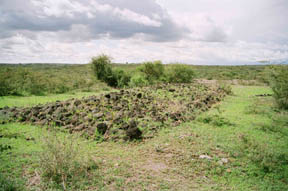Laetoli
The Lower Paleolithic site of Laetoli in Tanzania is famous for its human footprints, preserved in volcanic ash (Site G). The site is located 45 km south of Olduvai.

Date
The site is Pliocene, dated by the K/Ar method to 3.7 million years ago.
The footprints
A line of hominid footprints, discovered in 1976-77 by Mary Leakey, Richard Hay and their team, is preserved in powdery ash from an eruption of the 20 km distant Sadiman Volcano. Soft rain cemented the ash-layer (15 cm thick) to tufa without destroying the prints. In time, they were covered by other ash deposits. The hominid prints were produced by three individuals, one walking in the footprints of the other, making the original tracks difficult to discover. As the tracks lead in the same direction, they might have been produced by a group- but there is nothing else to support the common reconstruction of a nuclear family visiting the waterhole together.
| hominid 1 | hominid 2 | |
|---|---|---|
| length of footprint | 21.5 cm | 18.5 cm |
| width of footprint | 10 cm | 8.8 cm |
| length of pace | 47.2 cm | 28.7 cm |
| reconstructed body-size | 1.34-1.56 m | 1.15-1.34 m |
The footprints demonstrate that the hominids walked upright habitually, as there are no knuckle-impressions. The feet do not have the mobile big toe of apes; instead, they have an arch (the bending of the sole of the foot) typical of modern humans. They seem to have moved in a leisurely stroll.
Other animals
Other prints show the presence of twenty other animal species, among them hyenas, wild cats (Machairodont), baboons, wild boar, giraffes, gazelles, rhinos, several kinds of antelope, hipparion, buffalo, elephants (of the extinct Deinotherium genus), hare and birds. Traces of raindrops can be seen as well. Few prints are superimposed, which indicates that they were rapidly covered up again. Most of these animals are represented by skeletal remains as well.
Human remains
The remains of 13 hominids have been found, mainly mandibles and teeth. They show affinities to the female skeleton Lucy from Hadar, Ethiopia. Most scholars classify them as Australopithecus afarensis, but some stress the greater similarity to Homo and prefer to speak of Homo sp. indet.
A rather complete skull found at Ngaloba in 1976 has been dated to ca. 120 000-100 000 years BC. It is very modern anatomically, with a cranial capacity of ca. 1.200 cm³, but the forehead is still very low.
Artifacts
No artifacts have been found in the vicinity. It is probable that stone was not yet used for tool production.
Further reading
- Mary D. Leakey and J. M. Harris (eds), Laetoli: a Pliocene site in Northern Tanzania (Oxford, Clarendon Press 1987). ISBN 0198544413.
- Richard L. Hay and Mary D. Leakey, "Fossil footprints of Laetoli." Scientific American, February 1982, 50-57.
References
External links
- Footprints to Fill : Flat feet and doubts about makers of the Laetoli tracks - Scientific American Magazine (August 2005)
